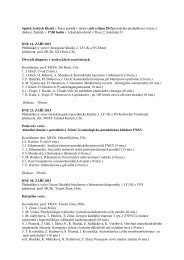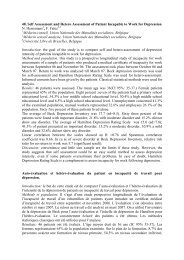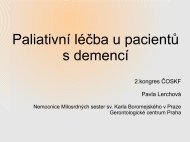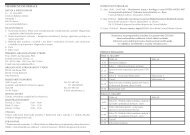ABSTRACTS â ORAL PRESENTATIONS - AMCA, spol. s r.o.
ABSTRACTS â ORAL PRESENTATIONS - AMCA, spol. s r.o.
ABSTRACTS â ORAL PRESENTATIONS - AMCA, spol. s r.o.
You also want an ePaper? Increase the reach of your titles
YUMPU automatically turns print PDFs into web optimized ePapers that Google loves.
We have tested optimal composition and performance of the screening tubes over 4<br />
modifications of 8-color panel on the total of 270 peripheral blood samples from patients<br />
and healthy donors. Of them, there were 29 patients with molecularly defined mutation<br />
and 56 patients with Common variable immunodeficiency (CVID). We have reached<br />
concordance with standard 4-color tubes. Major perturbations (absence of lymphocyte<br />
subset) were correctly detected in Severe combined immunodeficiency (SCID) and<br />
Cartilage-hair hypoplasia (CHH). Maturation perturbations, such as absence of memory<br />
B cells or memory T cells were detected in Hyper IgM syndrome (HIGM), Wiskott-Aldrich<br />
syndrome (WAS), DiGeorge syndrome (DGS) and CVID. Dedicated 8-color tubes focused<br />
on maturational stages of T or B cells further investigated individuals with abnormal<br />
results of the EuroFlow PID screening tube.<br />
EuroFlow PID screening tube allowed us to detect abnormalities in all major lymphocyte<br />
subsets. Standardization of the sample preparation protocols and data acquisition allows<br />
for multi-centric evaluation of the rare diseases and will also enable sharing anonymized<br />
phenotype data to facilitate diagnostic process and expand our understanding of cellular<br />
immunity in PID.<br />
Acknowledgements: Supported by grant NT/13271, NT/13287-4, NT/11414-5<br />
P47. THE USE OF FLOW CYTOMETRY IN THE SELECTION OF PROBIOTIC BACTERIA<br />
Dagmar Mudronova, Radomira Nemcova, Dana Ryznerova<br />
Department of Microbiology and Immunology, University of Veterinary Medicine and<br />
Pharmacy, Kosice, Slovak Republic; mudronova@uvlf.sk<br />
Flow cytometry is mostly used for identification, counting and testing of some properties<br />
of eukaryotic cells. In recent years, however, increasingly being used in microbiology,<br />
especially for counting and viability testing of bacteria. Any potentially successful probiotic<br />
bacteria designated for oral administration must fulfill some selection criteria. They<br />
must be able to survive and grow in the gastrointestinal tract conditions and to adhere<br />
to the mucosa of the gut. It is also necessary to respect the origin of the strain used and<br />
its ability to inhibit pathogens. The strain should be precisely identified, safe, genetically<br />
stable, it should have good growth properties, to maintain its high viability at processing<br />
and when in storage. Depending on the desired outcome, a probiotic strain may need to<br />
have additional properties, such as anticarcinogenic or hypocholestrerolemic effects, or<br />
the ability to improve lactose utilization (Nemcová, 1997). In the first phase of selection,<br />
most of the properties are tested in in vitro conditions. For tests on the gastrointestinal<br />
tract and technological process survival are often used conventional, time- and materialconsuming<br />
microbiological methods. An alternative, rapid and reliable technique for<br />
viability assessment seems to be flow cytometry (Bunthof et al., 1999). The aim of this<br />
study was to investigate the survival of beneficial bacteria in simulated gastrointestinal<br />
conditions and during the technological process by flow cytometry.<br />
For the simulation of the gastrointestinal tract conditions was prepared artificial gastric<br />
juice with pH adjusted to different levels, intestinal juice and bile salts solutions with<br />
Analytical Cytometry VII 143








